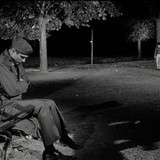- Master Conflict: a prostitute was killed in Paolino park in Rome
- Sub-Plots: Police investigation showcases stories of five witnesses that depict how their day started and what they saw when it finishes in Paolino park
- Themed Character: Roman rain that drives characters to seek shelter, triggering transitions to portrayal of the prostitute at different stages of her day before meeting her nocturnal fate.
 Paolino Park where all witnesses congregate and the victim – prostitute in the far left
Paolino Park where all witnesses congregate and the victim – prostitute in the far left
The above are the building blocks of an Italian cinema masterpiece, written and directed by Bernardo Bertolucci based on a story by Pier Paolo Pasolini. The backdrop story is that Bertolucci has started his career assisting Pasolini in his first feature film Accatone a year earlier. He describes this experience as “witnessing the birth of cinema” as neither Pasolini nor him had any experience making films. All Pasolini wanted was close up angles of the protagonists that should resemble tormented faces of religious saints, sacrificed on the altar as depicted in timeless Tuscan paintings.
In this film you will find the typical Pasolinian themes of the rough life of poor boys on the fringe of society and their struggles to find meaning in a chaotic environment. Pasolini convinced Cinecitta’ executives to allow Betrolucci and Franco Citti to turn his story into screenplay. However by the time the script was ready, Pasolini was completely busy tending to his film Mamma Roma (1962), so luck and ample talent crossed path and the assignment of directing the film was given to 21 year old Bertolucci who had never before directed a full feature film.
In the Criterion’s interview of this disc, Bertolucci confesses to the initial disbelief sentiment the entire set had towards taking orders from a young unknown 21-year old. What I found interesting is that although Bertolucci tried to personalize the film with his signature poetic style of keeping the camera always in movement as it followed the characters’ individual trajectories towards the park crime scene, emphasizing the element of the passing hours as a prosaic manifestation of the ordinary and life-like realism – critics only saw the Pasolinian influence dominating. It tells you a lot about the delicate balance between screenplay and directing style, especially when the story comes from such a powerful source as Pasolini.
The film brings another fine auditory gem; a brooding suspense of the park scenes countered with a jovial jazzy street life – a genuine score
by classic composer Piero Piccioni. With that, the film opens up a window to a Pasolinian Rome coined in his signature novel “Ragazzi di vita” of the early 60’s, depicting rough urban realities of adolescents at the lowest social rung: the faces, the fashion, the accents, the architecture, the cars, and yes the music that paints it all with a rich depth.
You will find the story structure following Akira Kurosawa’s Rashômon (1950), where a master scene is being reflected by myriad of point views, in this case of the five eye witnesses, each revealing another layer that was not visible through the others.
Think about the next time you read the paper about the latest crime scoop, which serves as the only valid conclusion but what caused it often carries multiple conflicting agendas, which validates once again that the truth is indeed in the eye of the beholder.


2 comments